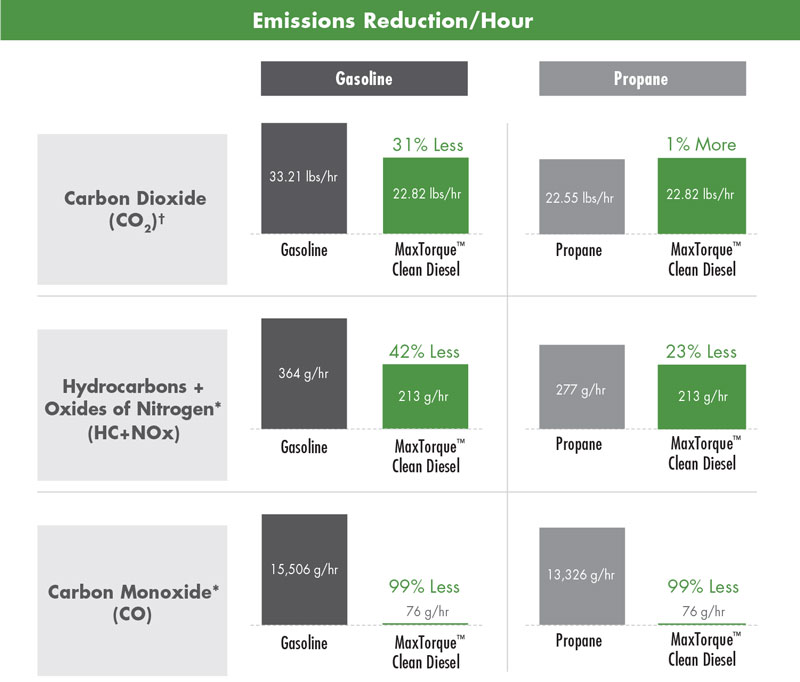A Responsible Alternative
As sentinels of the green industry, landscape professionals and rural lifestylers are ready to do everything possible to reduce the carbon footprint left behind by their green space maintenance.
Efficient use of power is key to reducing consumption and emissions, so it's no surprise that diesel is the fuel of choice that powers most hard-working equipment, including tractors, construction equipment, buses and heavy trucks.
Diesel is dependable. With over a century of development, diesel engines are proven performers in all types of commercial equipment.
The reason is that diesel delivers a lot more power in less quantity, allowing work to be performed efficiently with less consumption. As a result, diesel is still the best alternative when it comes to commercial mowing equipment.
On the flip side, liquid propane (LP) and compressed natural gas (CNG) are rarely used to power hard-working equipment.
Cleaner fuel processing and engine technologies have put Clean Diesel on par with or superior to other commercially viable fuels today. It is readily available, clean, powerful and economical, especially considering the operating costs of the mower over the life of the machine.
According to the Environmental Protection Agency, technological advances and stricter guidelines have allowed Clean Diesel to become one of the cleanest burning fuels available, and off-road diesel fuels are fast approaching par with on-road diesel. In fact, Grasshopper diesel models are ahead of the curve with the use of EPA Tier 4 Final-compliant, fuel-efficient engines.
According to the Environmental Protection Agency (EPA), "the reductions in NOx and particulate matter from non-road diesel engines, similar to those technologies used in highway diesel trucks and buses, will provide enormous public health benefits." The elimination of sulfur and other impurities also makes diesel significantly cleaner than in years past. The question is how much cleaner is diesel than other alternatives for zero-turn mowers.
When comparing emissions per hour of mowing, data collected from the EPA show that LP-fueled engines emit nearly equal levels of carbon dioxide (CO2), but emit higher levels of hydrocarbons + oxides of nitrogen (HC+NOx) and carbon monoxide (CO) than Clean Diesel mowers. Certification results from the California Air Resources Board (CARB) also indicate that LP-fueled engines emit much higher levels of oxides of nitrogen (NOx) and carbon monoxide (CO) than comparable Clean Diesel Engines. The table below illustrates sample 2016 emissions results from the EPA and CARB:

The diesel engine represented in this chart is used in Grasshopper equipment. Though it is larger and more powerful than the closest comparable gasoline models, it emits less carbon dioxide, non-methane hydrocarbon, less oxides of nitrogen and less carbon monoxide than the smaller gasoline and LP engines. NOx represents a source of greenhouse gas, and carbon monoxide is a deadly, odorless gas. In light of this, the cleaner, economical alternative for the landscape professional is a diesel-powered Grasshopper mower.
The liquid-cooled, 3-cylinder MaxTorque™ diesel engines used in Grasshopper models are compatible with B5 diesel, which means that up to 5 percent of the diesel fuel mix can be from non-petroleum, renewable resources.
So not only does the diesel-powered product allow you to complete mowing jobs using less fuel, but fossil-fuel consumption can be lowered by an additional 5 percent with B5 fuel blends.
Alternative fuels, including wind, solar, ethanol, natural gas, diesel and propane, are taking their rightful places in the overall energy supply chain, but those of us with time constraints and tough mowing conditions must rely on performance and proven technology to dependably deliver the services our customers require.
This is why Clean Diesel rises to the top of the list of energy alternatives, as it is clean, powerful, readily available and dependable.

